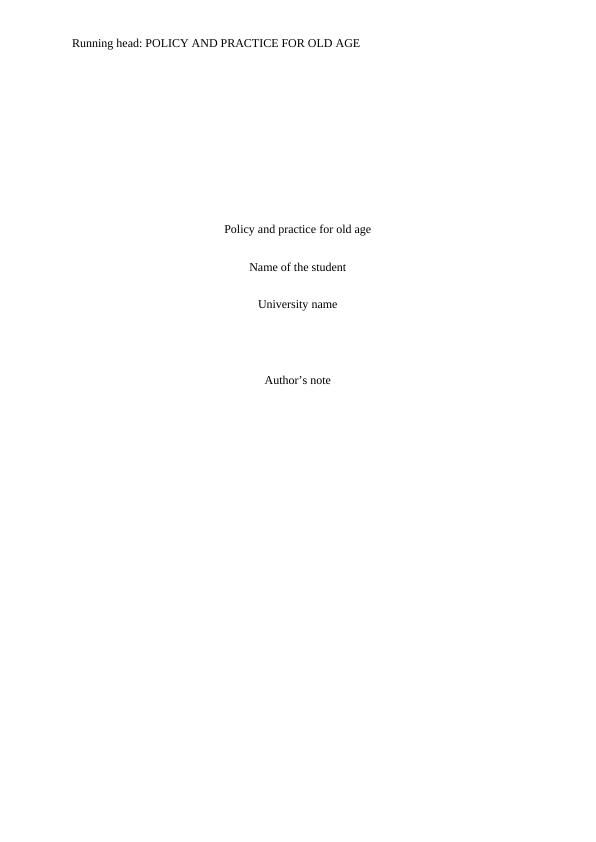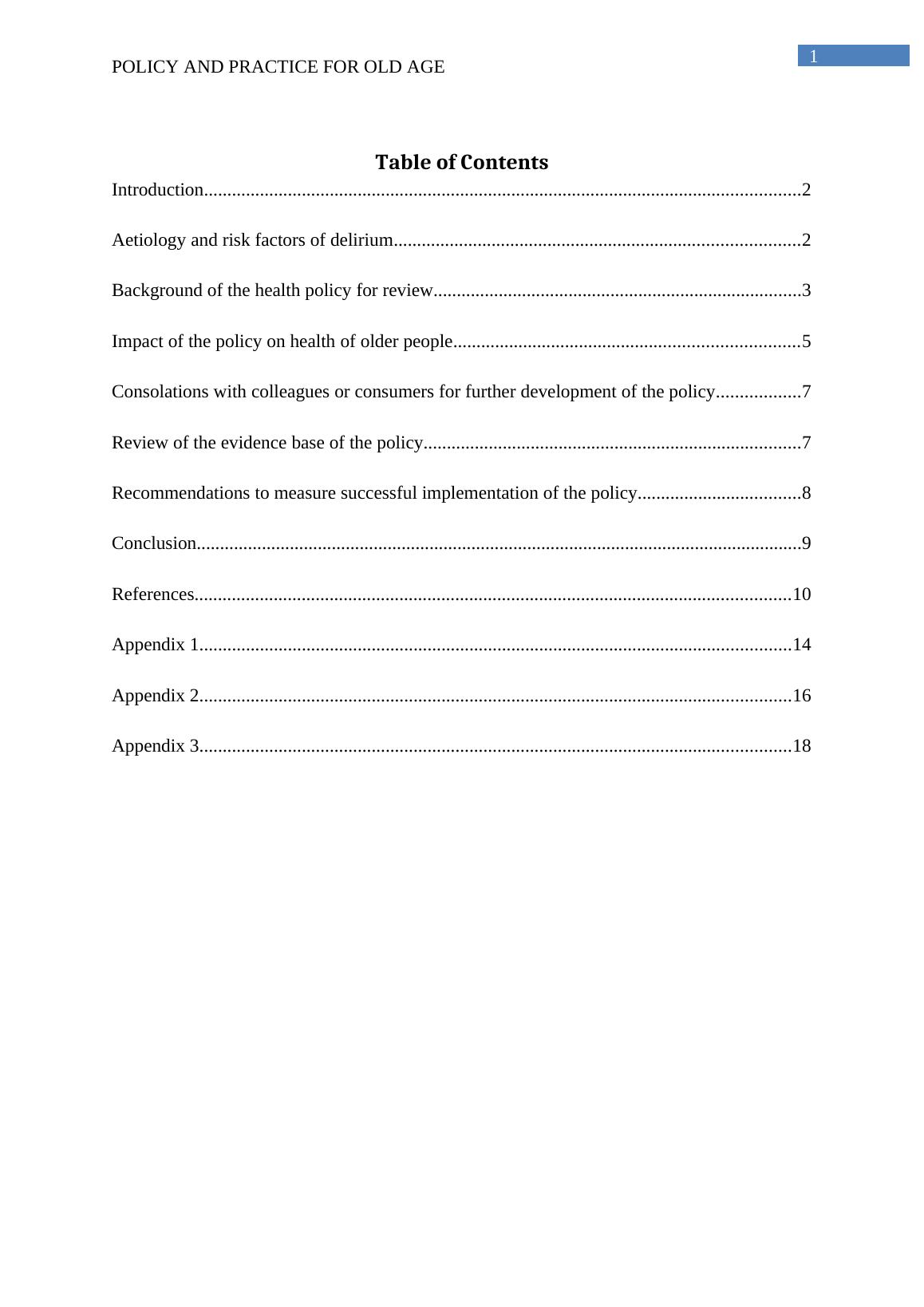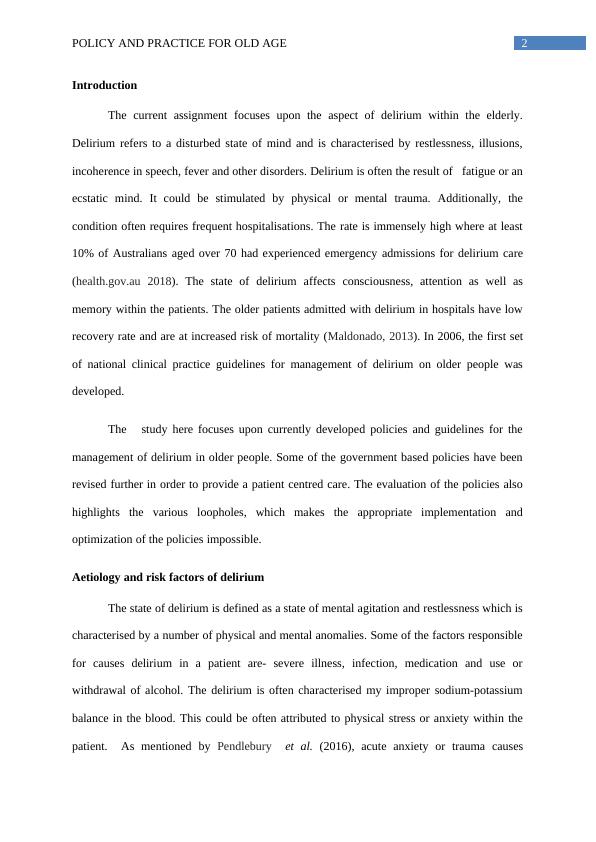Policies and Practice For Old Age (pdf)
19 Pages4575 Words67 Views
Added on 2021-06-16
Policies and Practice For Old Age (pdf)
Added on 2021-06-16
ShareRelated Documents
Running head: POLICY AND PRACTICE FOR OLD AGEPolicy and practice for old ageName of the studentUniversity nameAuthor’s note

1POLICY AND PRACTICE FOR OLD AGETable of ContentsIntroduction................................................................................................................................2Aetiology and risk factors of delirium.......................................................................................2Background of the health policy for review...............................................................................3Impact of the policy on health of older people..........................................................................5Consolations with colleagues or consumers for further development of the policy..................7Review of the evidence base of the policy.................................................................................7Recommendations to measure successful implementation of the policy...................................8Conclusion..................................................................................................................................9References................................................................................................................................10Appendix 1...............................................................................................................................14Appendix 2...............................................................................................................................16Appendix 3...............................................................................................................................18

2POLICY AND PRACTICE FOR OLD AGEIntroduction The current assignment focuses upon the aspect of delirium within the elderly.Delirium refers to a disturbed state of mind and is characterised by restlessness, illusions,incoherence in speech, fever and other disorders. Delirium is often the result of fatigue or anecstatic mind. It could be stimulated by physical or mental trauma. Additionally, thecondition often requires frequent hospitalisations. The rate is immensely high where at least10% of Australians aged over 70 had experienced emergency admissions for delirium care(health.gov.au 2018). The state of delirium affects consciousness, attention as well asmemory within the patients. The older patients admitted with delirium in hospitals have lowrecovery rate and are at increased risk of mortality (Maldonado, 2013). In 2006, the first setof national clinical practice guidelines for management of delirium on older people wasdeveloped.The study here focuses upon currently developed policies and guidelines for themanagement of delirium in older people. Some of the government based policies have beenrevised further in order to provide a patient centred care. The evaluation of the policies alsohighlights the various loopholes, which makes the appropriate implementation andoptimization of the policies impossible.Aetiology and risk factors of delirium The state of delirium is defined as a state of mental agitation and restlessness which ischaracterised by a number of physical and mental anomalies. Some of the factors responsiblefor causes delirium in a patient are- severe illness, infection, medication and use orwithdrawal of alcohol. The delirium is often characterised my improper sodium-potassiumbalance in the blood. This could be often attributed to physical stress or anxiety within thepatient. As mentioned by Pendleburyet al. (2016), acute anxiety or trauma causes

3POLICY AND PRACTICE FOR OLD AGEvasoconstriction of the blood vessels limiting sufficient supply of blood glucose level to thebrain causing a situation of delirium. In older people multiple causes can co-exist such asage-induced cognitive impairment. Additionally, dependence on medications such astranquilizers can also affect the normal thinking patterns of the brain. There are 14.1%chances of delirium within the old age population suffering from dementia, as the memory aswell as normal cognition capacities of the patients are affected suffering from dementia(Tropea et al. 2008).A number of diagnostic tools could be used for the management of delirium. Some ofthese are confusion assessment method (CAM) andDelirium Rating Scale (DRS). The CAM-ICU method has been validated for use in intensivecare unit. The delirium risk levels could be determined based upon the vulnerability of thepatient and the precipitating factors. It could be further represented graphically on a scale oflow to high. When the precipitating factors are less and the patient is less vulnerable the riskof contracting delirium is the least. When the patient is highly vulnerable and theprecipitating factors are lesser in number, the patient is at moderate risk of developingdelirium or vice-versa. The patient who is highly vulnerable and exposed to more numbers ofprecipitating factors lies in the high-risk zone (health.gov.au 2018). Some of the precipitatingfactors for dementia are as follows- history of cerebrovascular stroke, past history ofhypertension which high blood cholesterol. Some of these can block the adequate flow offglucose to the brain resulting in state of delirium.Background of the health policy for review The policy has been developed by the Australian Government department of healthand ageing. It mainly focuses upon the delirium care pathways, which takes intoconsideration the risk factors and the alternative strategies. The policy suggested by the

End of preview
Want to access all the pages? Upload your documents or become a member.
Related Documents
Dementia, delirium and depression in the elderly: A reviewlg...
|3
|372
|170
Delirium in the Elderly: Analysis, Assessment, and Health Promotion Strategieslg...
|9
|2541
|291
LIFE STAGE CONSIDERATION LIFElg...
|9
|2450
|3
Symptom cluster and symptom managementlg...
|8
|2322
|13
18 Questions With Answers in DELIRIUMlg...
|9
|2378
|360
Case Study of The Patient Assignmentlg...
|12
|3233
|28
